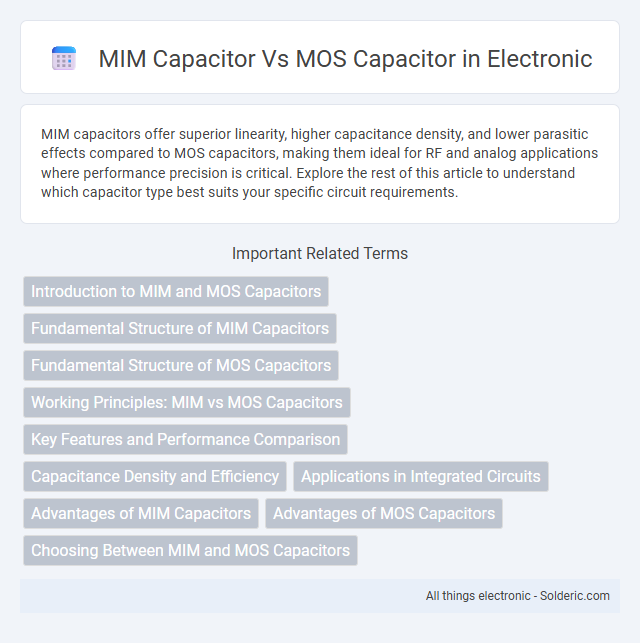MIM capacitors offer superior linearity, higher capacitance density, and lower parasitic effects compared to MOS capacitors, making them ideal for RF and analog applications where performance precision is critical. Explore the rest of this article to understand which capacitor type best suits your specific circuit requirements.
Comparison Table
| Feature | MIM Capacitor | MOS Capacitor |
|---|---|---|
| Structure | Metal-Insulator-Metal layered construction | Metal-Oxide-Semiconductor layered construction |
| Capacitance Stability | High stability with minimal voltage dependency | Capacitance varies with voltage due to depletion region |
| Operating Frequency | Ideal for high-frequency applications | Better suited for low-frequency or DC applications |
| Voltage Range | Wide voltage range with linear response | Non-linear response at high voltages |
| Leakage Current | Low leakage current, favorable for precision circuits | Higher leakage current due to semiconductor interface |
| Size and Integration | Compact with easy integration in RF and analog ICs | Sometimes larger due to depletion region effects |
| Applications | RF circuits, high-frequency filters, analog/mixed-signal ICs | Voltage sensors, MOSFET characterization, analog memory circuits |
Introduction to MIM and MOS Capacitors
MIM (Metal-Insulator-Metal) capacitors consist of two metal electrodes separated by a high-quality dielectric layer, offering high capacitance density and excellent linearity for analog and RF applications. MOS (Metal-Oxide-Semiconductor) capacitors feature a metal gate, an oxide insulator, and a semiconductor substrate, widely used in semiconductor device characterization and integrated circuit design due to their compatibility with CMOS technology. The key distinction lies in MIM capacitors providing stable capacitance with low parasitics, while MOS capacitors enable voltage-dependent capacitance essential for transistor operation analysis.
Fundamental Structure of MIM Capacitors
MIM capacitors feature a fundamental structure consisting of two metal plates separated by a thin insulating dielectric layer, allowing for high capacitance density and low parasitic resistance. This configuration contrasts with MOS capacitors, which utilize a metal-oxide-semiconductor interface where capacitance varies with voltage due to charge accumulation in the semiconductor. Your choice of capacitor type depends on circuit requirements for stability, frequency response, and integration complexity.
Fundamental Structure of MOS Capacitors
MOS capacitors consist of a metal gate, oxide layer, and semiconductor substrate, forming a metal-oxide-semiconductor structure essential for controlling charge distribution. The oxide layer acts as a dielectric, enabling capacitance by separating the gate from the semiconductor while influencing threshold voltage and device performance. This fundamental structure differs significantly from MIM capacitors, which rely on two metal plates separated by a dielectric without semiconductor involvement.
Working Principles: MIM vs MOS Capacitors
MIM capacitors operate using two metal electrodes separated by a high-quality dielectric layer, providing stable capacitance with low parasitic resistance and high-frequency performance. MOS capacitors consist of a metal gate, an oxide dielectric, and a semiconductor substrate, where capacitance varies with applied voltage due to the formation of depletion and inversion layers in the semiconductor. The fundamental difference lies in MIM capacitors relying on dielectric properties between metals, while MOS capacitors involve semiconductor charge modulation at the interface.
Key Features and Performance Comparison
MIM capacitors feature a metal-insulator-metal structure offering low parasitic capacitance, high linearity, and superior high-frequency performance, making them ideal for RF and analog applications. MOS capacitors utilize a metal-oxide-semiconductor structure with a variable capacitance dependent on gate voltage, suitable for digital circuits and charge storage but with higher leakage currents and nonlinearity under high frequency. The choice between MIM and MOS capacitors depends on circuit requirements, where MIM capacitors excel in stability and precision, while MOS capacitors provide integration benefits in CMOS processes.
Capacitance Density and Efficiency
MIM capacitors offer higher capacitance density due to their metal-insulator-metal structure, enabling efficient utilization of chip area compared to MOS capacitors, which rely on semiconductor interfaces and typically exhibit lower capacitance per unit area. The efficiency of MIM capacitors is enhanced by reduced leakage currents and higher linearity, making them ideal for high-frequency applications where stable capacitance is crucial. Your designs benefit from selecting MIM capacitors when maximizing capacitance density and performance efficiency is critical.
Applications in Integrated Circuits
MIM capacitors are preferred in integrated circuits for analog and RF applications due to their high linearity, low parasitic capacitance, and stability over temperature variations. MOS capacitors, commonly used in digital ICs, serve primarily as variable capacitors or threshold detectors but often exhibit higher leakage and variability compared to MIM types. Choosing the right capacitor impacts your IC's performance, especially in precision filtering, analog signal processing, and tunable circuits.
Advantages of MIM Capacitors
MIM capacitors offer superior linearity, higher capacitance density, and enhanced reliability compared to MOS capacitors, making them ideal for high-frequency and precision analog circuits. Their metal-insulator-metal structure provides low equivalent series resistance (ESR) and stable capacitance over a wide voltage range. These advantages lead to improved signal integrity and reduced distortion in RF and analog applications.
Advantages of MOS Capacitors
MOS capacitors offer advantages such as smaller footprint and simpler integration with CMOS technology, enhancing overall circuit density. Their voltage-dependent capacitance enables precise control in analog and mixed-signal applications. Additionally, MOS capacitors exhibit lower leakage currents and better compatibility with advanced semiconductor processes compared to MIM capacitors.
Choosing Between MIM and MOS Capacitors
Choosing between MIM and MOS capacitors depends on your specific circuit requirements and performance goals. MIM capacitors offer higher capacitance density, excellent linearity, and lower loss, making them ideal for RF and high-frequency analog applications. MOS capacitors provide ease of integration and tunability but typically exhibit higher leakage and nonlinearity, which may affect precision in sensitive designs.
MIM Capacitor vs MOS Capacitor Infographic

 solderic.com
solderic.com